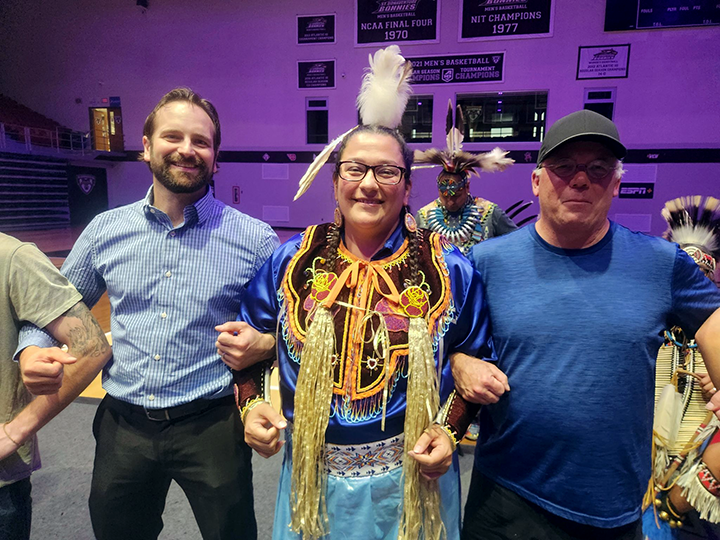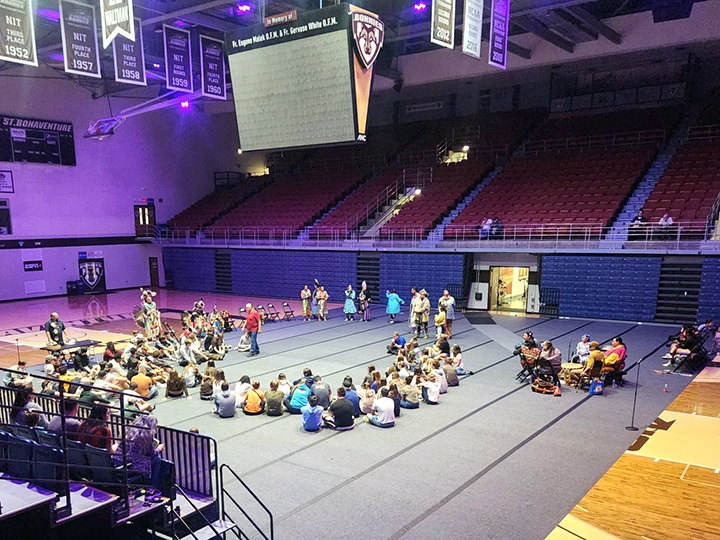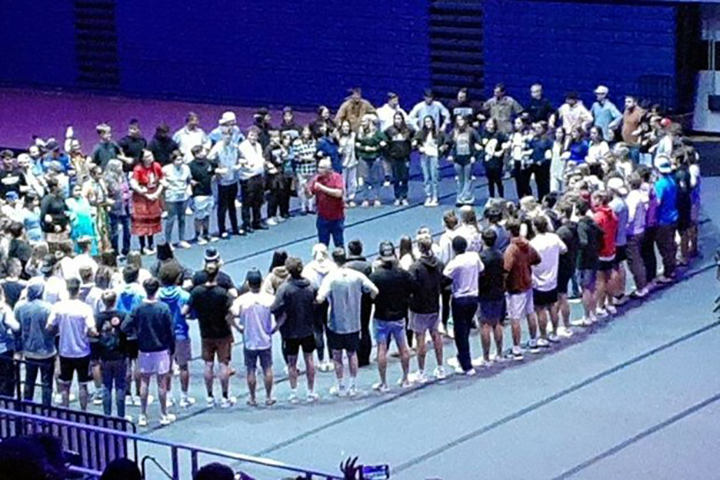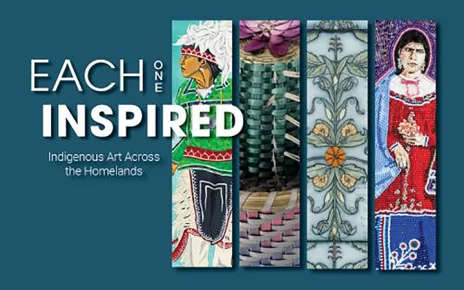September 18, 2023 | By Brooke Johnpier | tapinto.net
ST. BONAVENTURE, NY — Singing, dancing, the beats of drums, rhythms, history and culture were the highlights of the 2023 Fall Mini Powwow the Old Bridge Singers and other members of the Seneca Nation brought to the university’s Reilly Center Arena Thursday night.
The floor was dotted with dancers in various attire, the Old Bridge Singers sitting in a circle, and two Seneca men, Dennis Bowen and John Black, who shared a table on the sidelines and the role of announcers. The audience was seated in a middle section above the floor.
At 6:30 p.m., one announcer stood up, introduced who they were and what the purpose of the night was. Then he turned the floor over to St. Bonaventure University Provost Dr. David Hilmey, who gave an official introduction to the night.
The Old Bridge Singers started the powwow off with a bang. All eight men started beating on the drum that they were all seated around, and the lead and secondary singer began the first part of the song. The other six men chimed in to complete the rest of the song, ending with a loud thump. And the announcers told the crowd that the dances would begin.
The dancers walked in single file — first, four men; then, five women, and then, five children. They walked in a circle for the first three verses of a song. Two men had on full regalia which included headdresses, cloaks and furs. The other two men had on completely different outfits, and the one was decked out in neon yellow. The women’s clothes were brightly colored, One woman wore a blue-and-white dress; the other four wore tunics over pants. The children were dressed as colorfully as the adults.
The two men in regalia performed the first official dance of the night, a warrior dance. As the Old Bridge Singers sang and made music, the two men danced their hearts out. Once they finished, the crowd erupted into applause, and then the announcers began to tell some history.
“They tell the story of the protector, who is the defender of the people,” one said.
The two shared some more recent history, how in 1977 the elders of the Seneca Nation in the U.S. went to confer with Native people in Canada and decided the word indigenous best represents what their people truly are. They also told their audience the name Seneca is not their own; it was given to them by Europeans. Their true name is Onödowá’ga’, meaning the People of the Big Hill.
“The Duck and Dive,” a short dance, followed. Black and Bowen explained the dance comes from the Plains and that the two dancers wore feathers to represent the touching of the dead.
The next dance was only for the menfolk, boys included. The Old Bridge Singers kept time with their drum beats, and after a final boom, the dance was done.
The announcers told the audience that a lot of the songs performed are thank-yous. They also explained that some of the dancing done is known as grass dancing, which the Crow people in Montana introduced to the indigenous folk on this side of America.
Next, a Seneca man and a Tuscarora man performed what’s known as the smoke dance, an Iroquois war dance. When the dance ended, the announcers told the audience that the smoke dance is borrowed from the Osage people and is performed twice a year on Seneca Nation lands.
The hoop dance came next, performed by one young man who began by walking around the five yellow hoops on the floor. One announcer told the audience he would be picking up the hoops by sticking a moccasin under them and bringing them up to their knees before grabbing them with their hands.
“The hoops represent the circle of life,” once announcer said. “When the dancers came in earlier, the circle meant life. Every circle you see is a sign of life.”
The hoop dancer began “jumping rope” through one hoop, then proceeded to grab other hoops and make formations with them. Some he linked together to make an illusion of wings or a cloak; others he made into the form of a ball. The young man ended his dance by picking up the hoop ball and running off to thunderous applause.
And then the audience was called down to participate in a round dance. Approximately 150 people left the bleachers and went down onto the floor, forming two circles. The men were on the outside, and the women were on the inside. As the women’s circle went clockwise, the men’s circle went counterclockwise.
After the audience went back to their seats, the youth members danced. Then a woman who had not danced in many years performed.
`
Black and Bowen shared more history with the audience.They noted that in 1613, the Seneca made a treaty with the Dutch, the first made with Europeans. They then elaborated on why the woman had been bending over during her dance.
“When the women bend over, it’s to look for the tracks of their men or loved ones who have gone off to war,” they said.
Two women then came out in brightly colored dresses, each decorated with 365 silver-colored bulbs. Before they began dancing, the announcers explained that the bulbs represent each day of the year. With that said, the women burst into dance, accompanied by the music of the Old Bridge Singers music.
Women performed the next dances. Two were fancy shawl dances, and the women’s movements called attention to their beautifully colored shawls. Then the woman in the blue-and-white dress performed a lady’s smoke dance.
The announcers invited the audience to participate in an intertribal dance, which has the purpose of bringing people together no matter who they are. Everyone who went down to the floor got into a circle, and that circle moved for a good five minutes. Everyone was told to sit on the floor in whatever spot they were in, and that’s what the people did.
Black opened the floor to questions, and two were asked. “If you’re not indigenous, can you be in a powwow?”
“Yes, you can. You were just in one!” Black responded and added that some powwows are restricted, and the elders will let people know if they cannot participate.
“When you talk about the creator, is there a specific religion that you follow, or is it the same as all religions?” asked another audience member.
Black replied, “The word religion comes from overseas. We call religion a way of life.”
As the powwow came to a close, the Old Bridge Singers played music, and Black gave the microphone to dancer Sheldon Sundown, a member of the Turtle Clan.
“You don’t have to be Onödowá’ga’ to give thanks,” Sundown said. “When you wake up and go to sleep, give thanks to the creator.”







